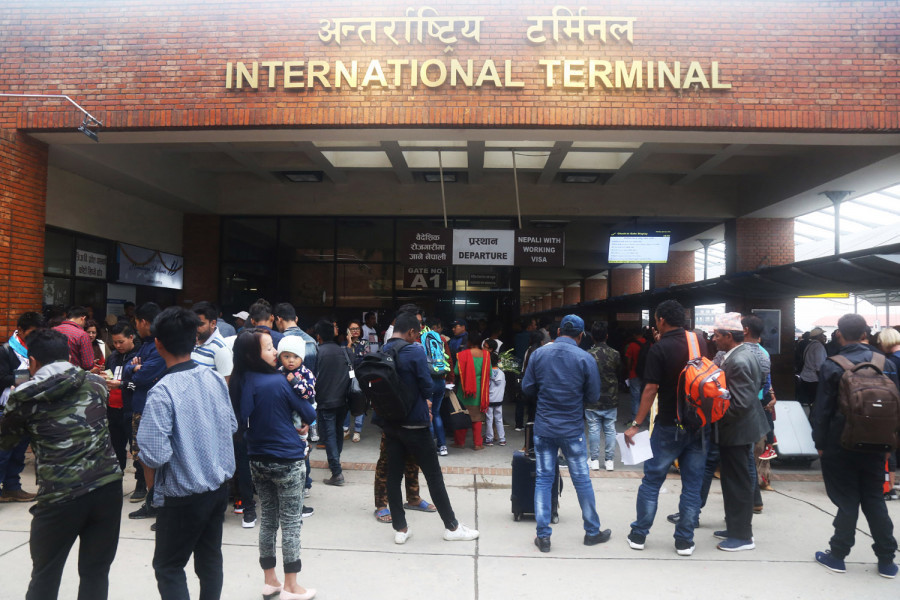Columns
Economics of remittance
Remittance as a source of income and foreign exchange is unsustainable and vulnerable in the long run.
Upen Pandey
Nepal has huge potential in the tourism, power (hydroelectricity), service and agriculture sectors. However, the country’s economic development has remained low. A low economic growth rate, a high poverty level, primitive and unscientific agriculture production, unemployment, low industrial development and a trade deficit, among others, have hindered progress. Despite these challenges, remittance, a significant foreign exchange source which covers around 25 percent of Nepal’s GDP, has sustained the economy for the past few decades. It has stabilised Nepal’s payment balance and financed nearly 84 percent of the trade deficit. According to Nepal Rastra Bank’s annual data for 2022-23, the remittance inflow stood at $9.33 billion in Nepal.
Remittance has also contributed to reducing the poverty level in rural families and increasing the internal migration rate from rural to urban areas for quality education, health, public services and better living standards. From a linear perspective, remittances seem perfect as a major development driver in Nepal. However, a comprehensive analysis of the economics of remittances requires a multidimensional and in-depth understanding.
Boon or ban?
We can’t deny the vital role of remittances in stabilising our economy, increasing income at the micro level and supplying foreign exchange at the macro level. Despite this, the question remains: Is this role sustainable at the micro and macro levels? The answer requires understanding the nature of the foreign jobs Nepali workers undertake to fund remittances.
For Nepali migrant workers, countries like Malaysia, Qatar, Saudi Arabia, India, and others are the top destinations. Nevertheless, earnings from foreign employment are unsustainable in two ways. First, since most Nepali workers work in resource-reliant (oil) and emerging economies—which experience frequent economic volatility—there is a high probability of losing jobs during shocks caused by plummeting crude oil prices in the world market. Similarly, financial crises, recessions and health shocks persist. Second, they are employed in low-skill, dirty, dangerous and demanding jobs. Nepal exports raw labour in exchange for remittances with little or no transformation in labour skills. When workers return to Nepal, there is little prospect of retaining new skills or technology that supports the domestic economy. As a result, remittances as a source of income and foreign exchange are vulnerable.
Window of opportunity
According to the theory of population economics, every country will experience a “demographic transition” at some point, opening the window of opportunity to harness and capitalise on the demographic dividend. This dividend period lasts for almost 50 years until lower fertility reduces the growth of the labour force, eventually closing the window. Industrial countries have completed this transition, and many emerging economies like Thailand, China and India have begun the dividend period. Nepal’s demographic opportunity has already opened, and it is now the appropriate time to accelerate economic development by optimally mobilising our labour force.
Unfortunately, Nepal is not seizing the limited opportunity to increase per capita income and accumulate assets, as foreign nations are mobilising the Nepali labour force for their economies. Nepal has to face a trade-off between current foreign income from remittances and lower accumulated physical assets in the future. Prioritising short-term remittances requires giving up on long-term domestic growth.
Macroeconomic stability can be measured through various financial and economic metrics such as price level, public debt, foreign exchange reserves, interest rates and fiscal deficits. Remittances are a crucial source of foreign exchange in Nepal, helping to maintain macroeconomic stability. To prove that foreign employment kills domestic growth, let us conduct a radical yet logical thought experiment. Suppose we assume there are limited opportunities for foreign employment, causing a reduced inflow of foreign exchange earnings. In that case, the country will face a foreign exchange reserves crisis, higher unemployment and poverty without a replacement for foreign exchange. This would compel the government to initiate robust policy choices, promoting trade and commerce, industry growth, tourism and agricultural development. However, in our case, the government is in a comfortable position of earning foreign exchange through foreign employment.
Policymakers in Nepal lack the motivation to craft and implement policies promoting growth. This comfort, in turn, has encouraged them to engage in power, patronage and populism. Remittance has reduced the political will to enact policy reform. Therefore, the opportunity cost of power and patronage-centred politics is a lower rate of growth and development in the long run.
In the short run, remittances can help achieve macroeconomic goals such as minimising current account deficits, raising income levels, escaping poverty traps, and protecting the public against adverse economic shocks. However, to reiterate, there are more significant costs of remittances in the long run as they are an unsustainable source of income and foreign exchange. Foreign employment precludes the Nepali economy from capitalising on the population dividend and inhibits achieving a higher economic growth and development rate. It also reduces incentives for the government to undertake necessary policy reforms. It all depends on the policymakers whether we seek short-term, unsustainable benefits from remittances or long-term sustainable goals by creating opportunities for our labour force to work and contribute to our economic development.




 7.73°C Kathmandu
7.73°C Kathmandu















